This is the nineteenth post in a series about my possible line of descent from Eleanor of Aquitaine. In the first post, I explained how I discovered the possible line, and how I am going to verify it one generation at a time. In the last post, I proved that my fourteenth great-grandmother Barbara Willems Pijlijser was the daughter of Willem Jans Pijlijser and Johanna van Wijfliet.
Johanna van Wijfliet, daughter of Willem van Wijfliet
Research into Barbara Willems Pijlijser turned up several records that mentioned Johanna van Wijfliet:
- Feudal records mentioned her as wife of Willem Pijlijser
- Charters from convents in Heusden mentioned her with her husband and children
- A court record from Den Bosch mentioned her with her parents.
- An anniversary book from Tilburg mentioned Willem van Wijfliet and wife Jenneken
These records will be analyzed for evidence about her parents.
Feudal registers
The earliest known record that mentions Johanna van Wijfliet with her husband Willem Pijlijser dates from 1459.
The feudal register of Lek and Polanen of 1459 shows that Willem Pijlijsers, son of the late Jan Pijlijsers, knight, with consent of the feudal lord, awarded his wife, the lady Johan van Wijffliet, her dowager rights after his death, in the tithes in Eethen in the Lange Broickaert.1
Willem Pijlijser also held land in fief from the Duke of Brabant. In 1446 he transferred 52 “morgen” [measure] of land called the “Nonnen weyde” [nun’s meadow] in Drunen to Jan Monick, who succeeded to the fief. On 14 June 1467, Willem Pijlijser succeeded to the fief on behalf of his minor son Jan, after transfer by Jan Monick. After Jan Pijlijser’s death, his daughter Joose Pijlijser, wife of Henrick den Rover, succeeded him on 14 November 1501.2
The register was kept in reverse order. The earliest entry was written at the bottom, and included a description of the property held in fief. Every time a new vassal succeeded to the fief, a new entry was written above the previous one. This particular fief has entries for the period 1446 to 1611.
In this time and place, the age of majority was 24.3 For Jan to have been a minor in 1467, he must have been born after 1443.
Heusden charters
A series of charters in the archives of the convents Mariënkroon and Mariëndonk in Heusden from 1473 and 1474 show how the estate left by Willem Jans Pijlijser and Johanna van Wijfliet was settled.
A charter of 13 September 1473 shows Jan Pijlijser owned 1/8th of the estate of Willem Pijlijser in Baardwijk, which Jan Pijlijser inherited on the death of lady Jan van Wijflit his mother.4 This indicates that Jan [Johanna] van Wijflit died by 13 September 1473.
On 11 November 1473, the aldermen of Heusden declared that Willem Pijlijser and his sons Jan and Hendrik transported land in Baardwijck to Godert Remboutszn. The land was encumbered with a tithe of 22 Burgundy “stuiver” [coin], that Henrik, Janna and Barbara, his sisters, would keep.5
On 20 December 1474, Godert Reijmboutszn promised to Henrick Pijlijser, Janna and Barbara, the children of Willem Pijlijser, a tithe of 22 Burgundy stuiver from land in Baardwijk.6
Den Bosch court records
A court record from Den Bosch of 27 July 1461 names Wijllelmus de Wijflet [Willem van Wijfliet] and his wife Johanne, daughter of Henrick Danels with their son-in-law Willem Pijliser, son of the late lord Jan Pijliser, knight, husband of lady Jenneke.7
The combination of Willem Pijlijser, son of Jan (which matches the feudal register) and wife Jenneke identifies the son-in-law as the Willem Pijlijser husband of Johanna Wijfliet mentioned above.
The same family appears in an estate settlement between the heirs of Elisabeth, widow of Henricus Danels, on 27 April 1480. Johannes de Wijflet, son of Willem de Wijfflet, for himself, and Henricus Pijlijser, son of the late Willem Pijlijser, for himself and for Johannes his brother and Johanna and Barbara, his sisters, children of the late Willem Pijlijser, divide the estate of Elisabeth the widow of Henricus Danels, grandmother of Johannes de Wijfliet and great-grandmother of Henrick Pijlijser and his brother and sisters.8 Though Johanna van Wijfliet is not mentioned in this record, this record mentions her children as the great-grandchildren of her grandmother in the 1461 record, confirming the relationships.
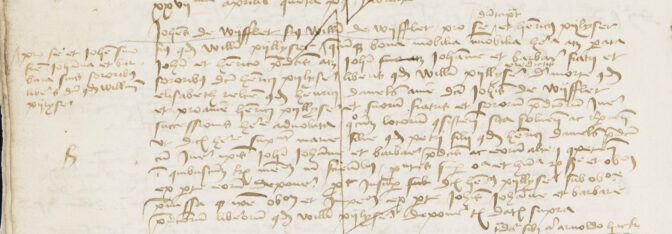
1480 estate division
Illustrous Dear Lady Brotherhood
Around 1300, a community of clerics came together to celebrate and venerate the lady Mary in the St. Janskerk [St. John’s Church]. This group was officially recognized as a brotherhood in 1318 and had its own chapel in the St. John Cathedral. From 1371 onward, the brotherhood admitted lay members, both men and women. They would pay to enter the brotherhood, and receive benefits like indulgences. The account books of the brotherhood have been preserved.9

St. John’s Cathedral in ‘s-Hertogenbosch. Photo by author.
The ledger for 1440/1441 shows a payment of 2 pounds for the entry fees of Lijsbeth, wife of Henric Danels son, and Jan^ her daughter, Willem’s wife van Wijflet.10 The abbreviation mark after Jan’s name shows she was probably called Janna. The part mentioning Janna being Willem’s wife van Wijflet seems to be in slightly different color ink and may have been added later.
This shows that Willem van Wijflet was married to Jan[na], daughter of Henric Danels and Lijsbeth. Janna is a variation of Johanna/Johanne, the name of Willem van Wijfliet’s wife in the 1461 Den Bosch court record. The brotherhood entry payment provides independent evidence of the identity of his wife.
Entry for entrance fees
Anniversary book
An anniversary book from the church of Tilburg provides further evidence. This book was started between 1502 and 1509, and records all the income promised to the church for masses to be said on the anniversaries of people’s deaths.
An entry for 6 November identifies the anniversary of Wilhelmus Wijfliet and his wife Johanne, who donated for their annuity three “lopen” [measure] of corn from their estate, now paid by Peter die Paep.11 The writing is in the hand identified by Boeren as one of the original writers in 1502 to 1509, the person who added the financial transactions to the book.12
This entry shows that by 1502 to 1509, Peter die Paep paid for the masses of Willem Wijfliet and his wife Johanna. We know that Johanna Wijfliet was the mother of Peter die Paep’s wife Barbara. This provides another link between Barbara and her maternal grandparents. It also shows that Willem Wijfliet and Johanna had a connection to Tilburg, the place where Barbara lived.
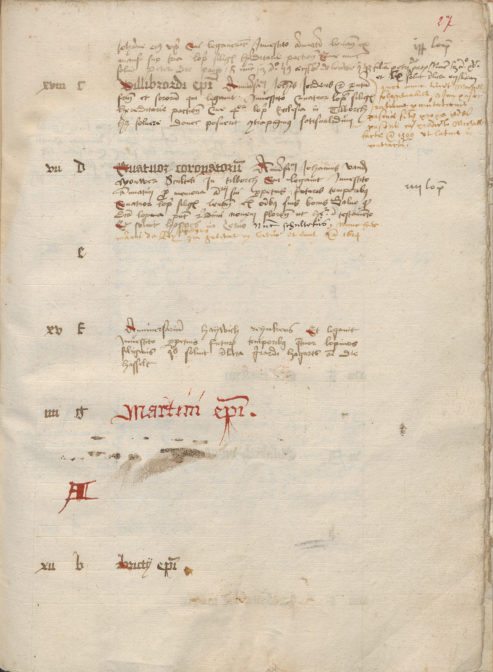
Anniversary book: entry starts at bottom of the first page and continues on the top of the second page.
Naming patterns
According to the Heusden charters, Willem Pijlijser and Johanna Wijfliet named a daughter Janna, a variation of Johanna/Jenneken. They did not have a known son Willem.
It is possible that Willem Wijfliet was still living when they had their children, since in this area usually only deceased people were named after. It is also possible that they did name a son Willem, but that he died young.
Son Hendrik may have been named after Henrick Daniels, Johanna’s grandfather, who died by 1480.
Conclusion
A combination of evidence proves that Johanna Wijfliet, the wife of Willem Pijlijser, was the daughter of Willem van Wijfliet and Johanna, the daughter of Henrick Danels and his wife Lijsbeth.
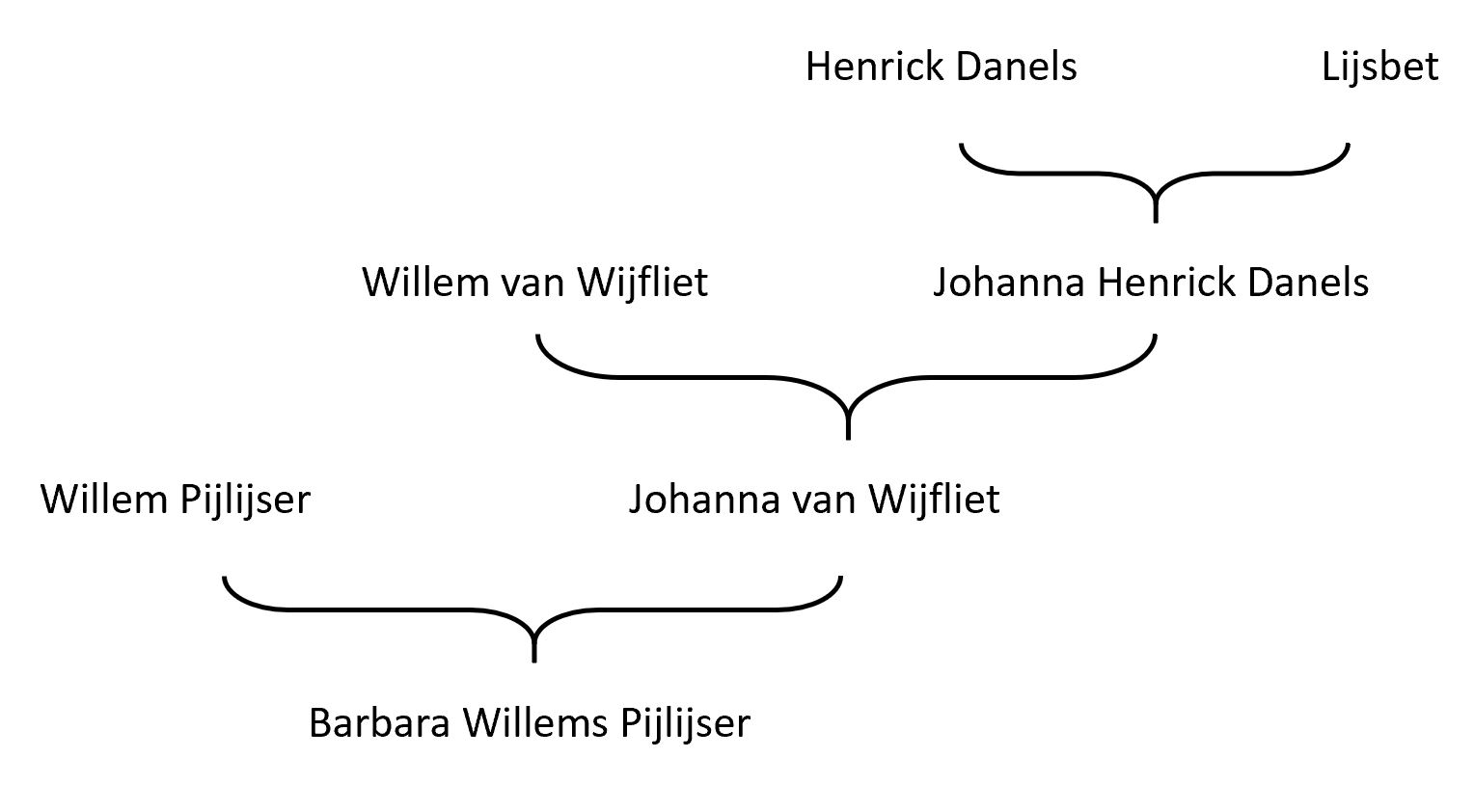
Willem Pijlijser and Johanna Wijfliet were recorded as husband and wife in feudal records (1459) and charters (1473, 1474). A 1461 court record names Willem Pijliser, son of the late lord Jan Pijliser, knight, husband of lady Jenneke, as the son-in-law of Willem van Wijfliet and his wife Johanna, daughter of Henrick Danels. The 1480 estate division of Elisabeth, widow of Henricus Danels, names the children of Willem Pijlijser as her great-grandchildren. Janna, wife of Willem Wijfliet, daughter of Lijsbeth, the wife of Henrick Danels, entered the Illustrous Dear Lady Brotherhood in Den Bosch in 1440-1441.
Willem Pijlijser and Johanna Wijfliet named a daughter Janna, probably after Johanna’s mother. No evidence was found for a son Willem named after her father, but a son Willem could have died young or the grandfather may have died after the birth of the last child. Son Hendrik may have been named after Johanna’s grandfather Henrick Daniels.
Willem van Wijfliet and his wife Johanne paid an annuity to have masses said in the church in Tilburg. This annuity was later paid by Peter die Paep, the husband of Johanna van Wijfliet’s daughter Barbara Willem Pijlijsers. Barbara would have been their granddaughter, which explains why her husband kept up the payments.
The combination of this evidence proves that Johanna van Wijfliet, the wife of Willem Pijlijser, was the daughter of Willem van Wijfliet and Johanna Henricks Daniels.
That’s eighteen generations down, just ten to go!
Next up: Generation 19 – Willem van Wijfliet.
Sources
- Domain of the Lek and Polanen, feudal register A, 1468-1484, fol. 27v-28r, Willem Pijlijser and Hendrick Pijlijser fiefs; call no. 7319, Nassau Domain Council, Record Group 1.08.11; National Archives, The Hague.
- Feudal administration of Brabant, “Bossch Strick Grefier,” fiefs of the Duke of Brabant in the city and district of ’s-Hertogenbosch, p. 463, Nonnenweide in Drunen; call no. 1111, Council of Brabant, Record Group 19; Brabants Historisch Informatie Centrum, Den Bosch; finding aid and images, Archieven.nl (http://www.archieven.nl : accessed 25 February 2019).
- Victor van Beughem, Costuymen, ende usantien der hooft-stadt ende meyerye van s’Hertoghen-Bossche (‘s-Hertogenbosch: Jan Scheffers, 1684), p. 120, title 17, of minor children and guardianships, articles 2; imaged as Google Books (https://books.google.nl/books?id=zadpAAAAcAAJ : accessed 25 February 2019).
- Land titles of land in Baardwijk, charter 1212, Henrik Ynwijnszn claim to land of Jan Pijlijser (13 September 1473); call no. 136, convents Mariënkroon and Mariëndonk in Heusden, record group 239; Brabants Historisch Informatie Centrum; finding aid and images, Archieven.nl (http://www.archieven.nl : accessed 24 February 2019).
- Land titles of land in Baardwijk, charter 1214, transfer of land by Willem Pijlijser and children (11 November 1473); call no. 136, record group 239, Brabants Historisch Informatie Centrum.
- Land titles of land in Baardwijk, charter 1259, tithe to Willem Pijlijser’s children (20 December 1474); call no. 136, record group 239, Brabants Historisch Informatie Centrum.
- Aldermen’s Court (‘s-Hertogenbosch), Bosch Protocol 1460-1461, fol. 214, Wijflet (27 July 1461); call no. 1231, Aldermen’s court of Den Bosch, Record Group 14; Erfgoed ‘s-Hertogenbosch, Den Bosch ; imaged as “Bosch protocol 1367-1809,” Erfgoed ‘s-Hertogenbosch (https://denboschpubliek.hosting.deventit.net/zoeken.php : accessed 25 February 2019).
- Aldermen’s Court (‘s-Hertogenbosch), Bosch Protocol 1479-1480, fol. 105v, estate division Elisabeth widow of Henricus Danels (27 April 1480); call no. 1249, record group 14, Erfgoed ‘s-Hertogenbosch.
- “Illustre Lieve Vrouwe Broederschap,” research guide, Brabants Historisch Informatie Centrum (http://www.bhic.nl/onderzoeken/hulp-bij-onderzoek/illustre-lieve-vrouwe-broederschap : accesse 25 February 2019).
- Illustrous Dear Lady Brotherhood, account book 1431-1448, fol. 117v, entry for Lijsbeth wife of Henrick Daniels and daughter Janna (1440-1441); call no. 118, Illustrous Dear Lady Brotherhood in ‘s-Hertogenbosch, Record Group 1232; Brabants Historisch Informatie Centrum, Den Bosch; finding aid and images, Archieven.nl (http://www.archieven.nl : accessed 25 February 2019).
- Roman Catholic Church (Tilburg), Liber Anniversiorum, entry for 6 November; call no. 546, collection acquisitions of the provincial archives Noord-Brabant, Record Group 339; Brabants Historisch Informatie Centrum, Den Bosch; finding aid and images, Archieven.nl (http://www.archieven.nl : accessed 24 February 2019).
- For an in-depth analysis of the various hands and their dates, see P.C. Boeren, “Het oudste Liber Anniversariorum der kerk van Tilburg” [The oldest Liber Anniversariorum of the church of Tilburg,” Bossche Bijdragen 22 (1953-1955), 116-144.
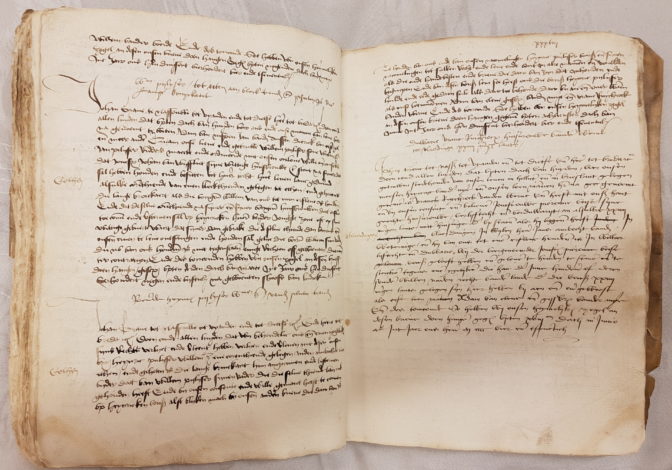
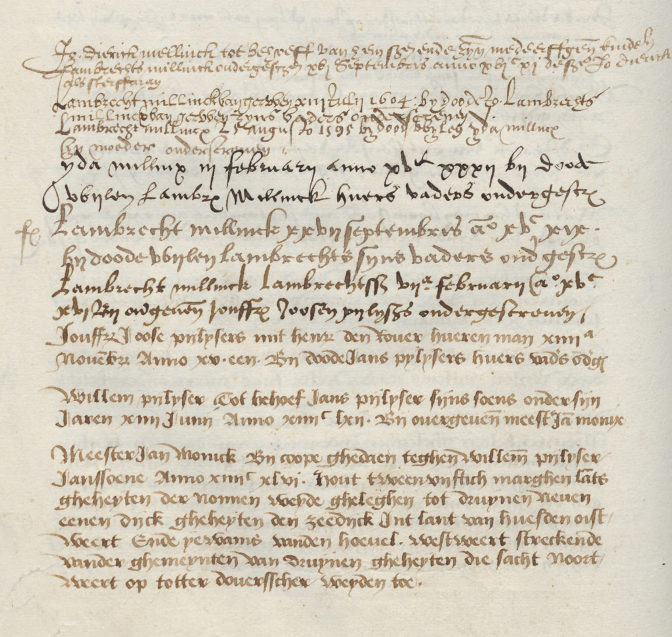
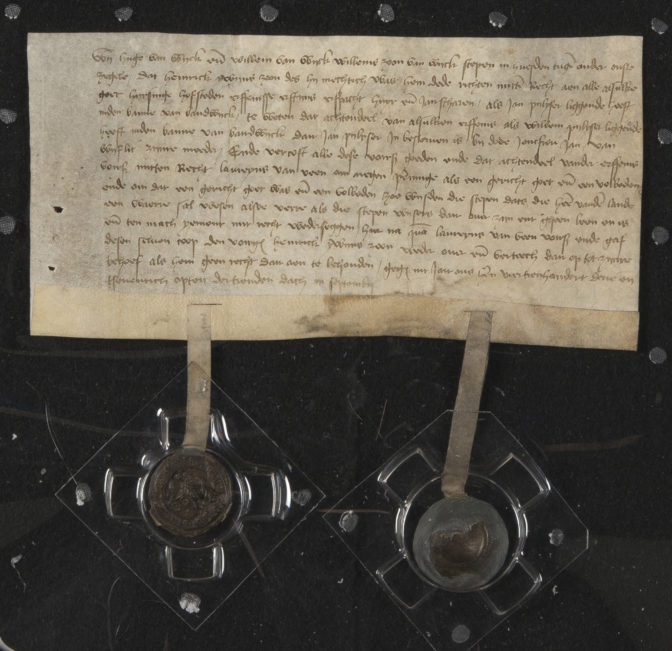
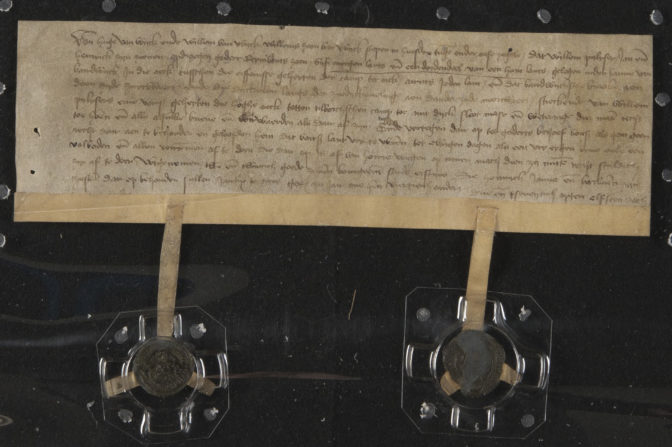
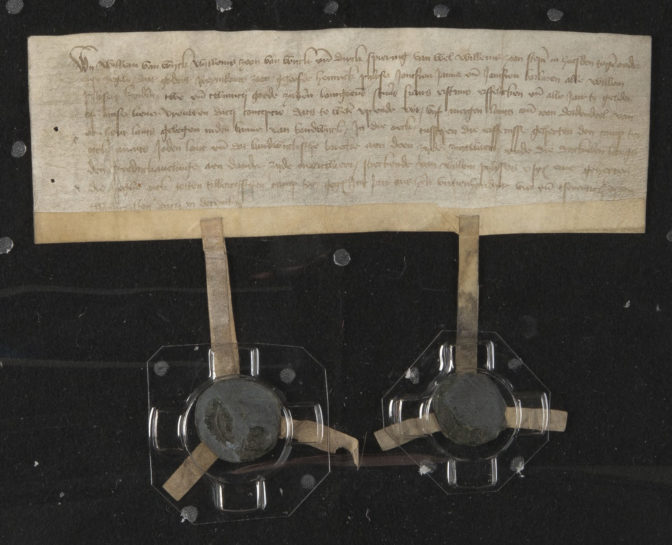

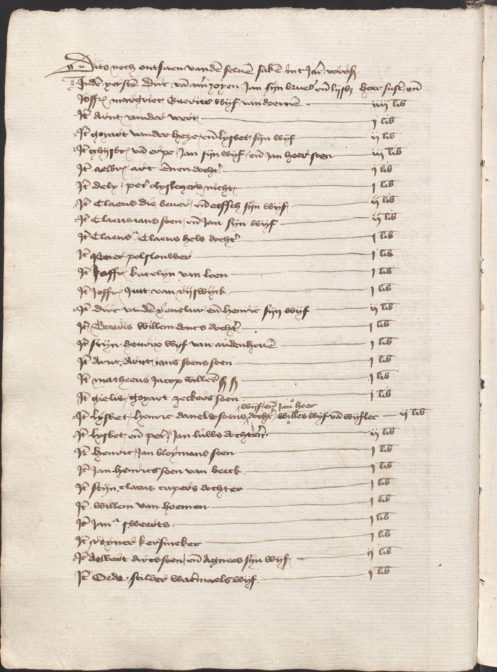

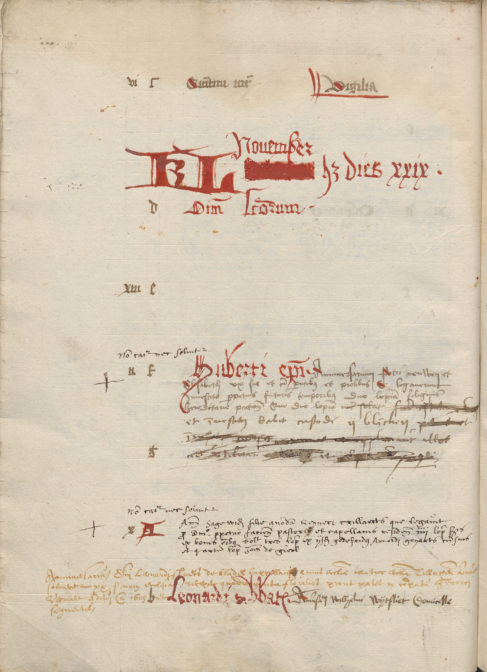


Wow! Great step-by-step linking with these resources. Impressive for the 1400s.
Love the clerk hands (writing) — an art form!
18 generations back, wow. How do you know which line to follow? Something must have clued you that you might descend from Eleanor, but how do you know which parent it was that will lead you to Eleanor?
I found a line in literature, but without much documentation. I’m verifying and documenting each generation as I go back.
Interesting to note that Jan Monicx (listed as receiving land from Willem Pijlijse in the feudal register) was the husband of Adriana Jan Pijlijser. Adriana was the sister of William Jan Pijlijser, and she is a direct ancestor of mine (if my research holds up!).
Hi cousin!
Goedenavond Yvette! Ik kijk met spanning uit naar je aankomende blogposts. Je werk is, zoals je in het Nederlands zegt, uitstekend.
Yvette, I’ve been reading this series from the beginning with great interest. I really appreciate how your line of reasoning is so clear. The records you have found are amazing! Keep up the great work. I can’t wait to see how this all turns out!